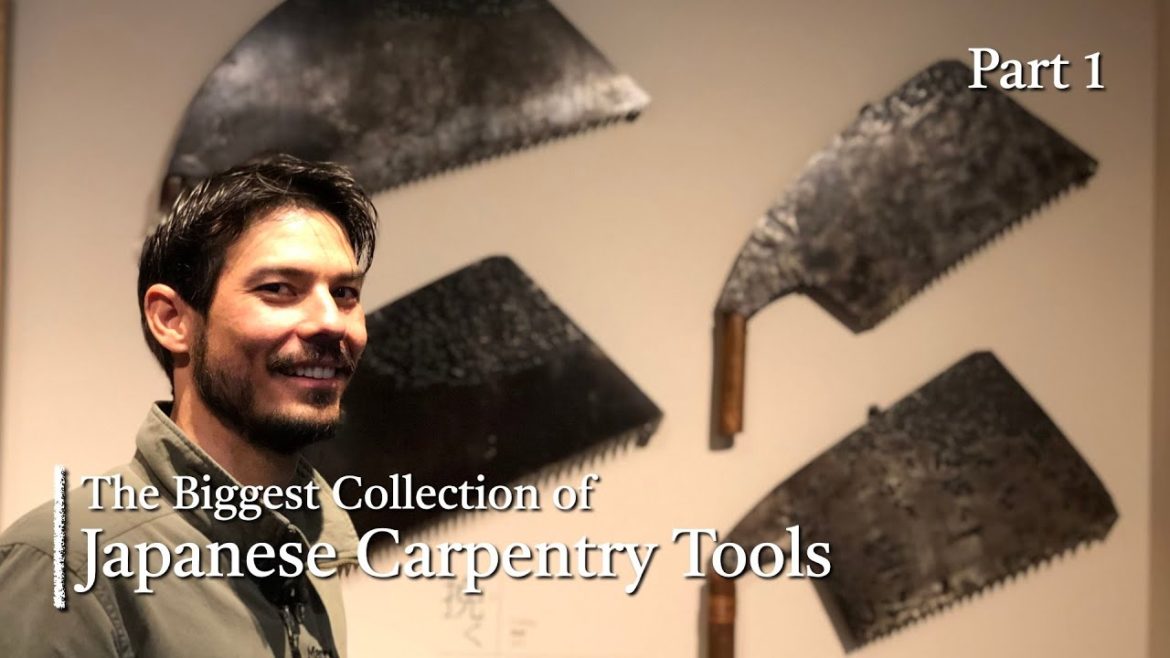Part 1: The Biggest Collection of Japanese Carpentry Tools in Japan – December 2020
In this video, we travel to Kobe, Japan where the Takenaka Carpentry Tool Museum is located. The museum hosts one of the largest collections of Japanese carpentry tools that have been acquired through the centuries. There are replica tools from the Jomon Era (5500 years ago) up until today. The interesting thing about the tools and the techniques used in carpentry is that they have not changed significantly. Of course modern tools like circular saws, electric planers and jointers, etc. are being used today, but they are not on display at the museum. In Japan, it is common practice to learn carpentry the traditional way, but due to rising costs and need for reasonable and timely construction, electric tools have been incorporated into daily work. However, this does not mean that traditional tools are obsolete, in fact traditional tools are used often in the finishing steps of a construction project. Keep in mind years ago there were many more carpenters and tradesman in the world so the number of people working on a single project was much higher than today. In Japan, the population of carpenters has been rapidly decreasing as many houses being purchased today are designed to be scrap and build where the homeowner will likely demolish the house after 30 to 50 years to make way for newer construction.
At the Takenaka Carpentry Tool Museum, we get the chance to look at the progression of tools from 5500 years ago up until today. The techniques may remain the same, but the tools and the materials used in the tools has gotten significantly better and more refined. There is a sense of immense pride in the museum for the Japanese craftsman as there are several displays showcasing metalworkers and carpenters from the past and the present. The skills it takes to make carpentry tools is extremely high and there for these tools do not come cheap. However, once you acquire a full set of Japanese chisels or a full array of Japanese planers this will last you a lifetime if properly taken care of. In many cases, these tools can be purchased from former carpenters at auction or even through direct deals.
What is great about this museum is the fact that you can touch a lot of the displays allowing you to get a better sense of the skills involved to build using traditional tools. The museum also has very well written English displays which helps to learn some of the names of the tools that are being used.
The Takenaka Carpentry Tool Museum is definitely worth the visit if you are interested in high quality Japanese tools.
#woodworking #japanesewoodworking #carpentrylife
https://www.instagram.com/leopardi.engineering/
Host:
G. Leopardi
Film Editor:
K. Yamashita
Cameras Used:
Olympus OMD EM-1 Mark III – HD (4k Video)
Sony ZV-1 – Vlogging Camera – HD (4k Video)


14 Comments
Why do you know about Japanese carpentry in detail? I was surprised.
The limb shaped adze with a stone cutter, looks almost the same as the northwest coast indian steel adze used today
Thanks for your videos, I feel nostalgic and it makes me wondering to come back to Japan. When I visit Takenaka I spent a whole morning to study its 3 floors and it was not enough 😄
Would it be possible to create informative videos, which your audience visits to learn about the specialised subject of Japanese carpentry, its customs, tools and underpinning philosophy without destroying the experience with an irritating backing track of halfwit dopeymusic getting in the way. Your subject is intensely interesting, but the authority of the words by which you are trying to impart some of this ancient and fascinating knowledge, is undermined by the tacky Western media drivel noise twittering along in the background. Backing noise isn't a fixed requirement and the excellent content does not need it. If you feel compelled to add noise, please make it appropriately traditional Japanese music instead of that insufferable mind-numbing garbage which spoils an otherwise very watchable video.
I'm very assigthing to go there, thanks for information..
Thank you for the video.
Wow !
I love Kobe even more now ! xD
A dream place for the lovers of carpentry ….
Thank you for share this with us, i appreciate so much !
This is an exemple how far we are from the ancestor … I can't thinking about how much we lose or how much we are late compare to them hahahaha
You don't have the same feelings, like we lost so many knowledge ?
Love Japan…and love your channel…just found ya.
Awesome awesome and awesome, thanks for these videos
Good review of the museum! love all the Japanese names – but I like how Japanese carpentry has change some "western" methods of work, like the pull saws! The Art of Carpentry and Craftsmanship is amazing! It is hard not to get enough of Asian talent! Without the tools of today we who dabble in wood working would not even know these master carpenters, woodworkers and artisans! Learning though your channel is great share! Steven Columbus Michigan USA
Really enjoyed this.
Yari ganna; is it correct that a yari is a spear, and it means literally a 'spear plane'?
Thank you
Thanks for sharing your experience on your traveling…
It's none of my experience .
But I love to see your liking 👍 ,how nicely you are presenting the Japanese carpentery skills which are really very impressive 👏
Something beyond imagination
Keep sending this type of videos .